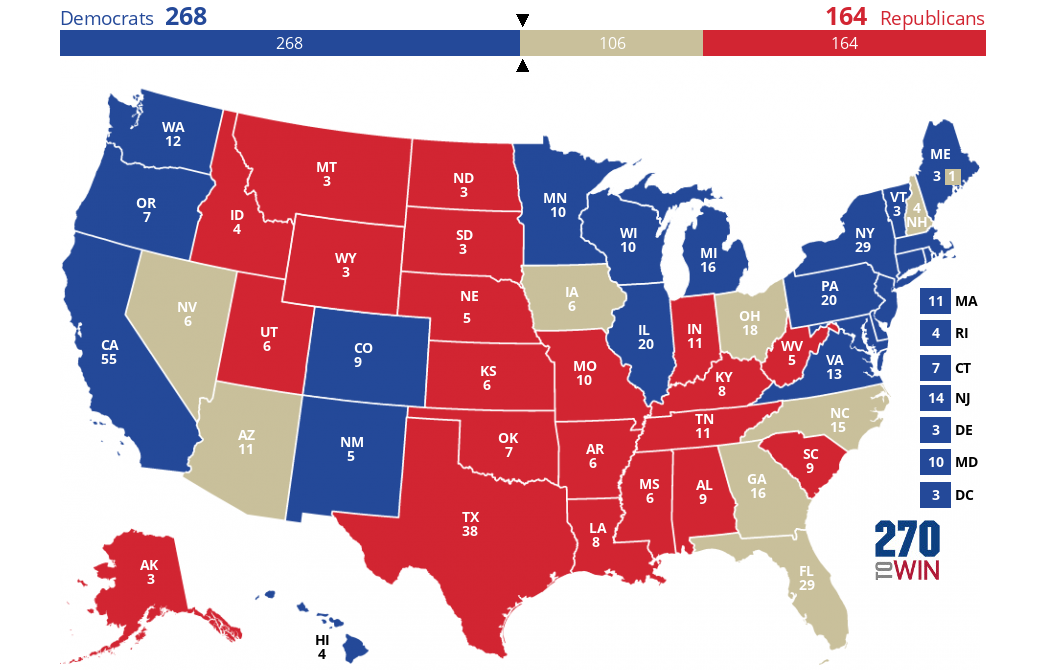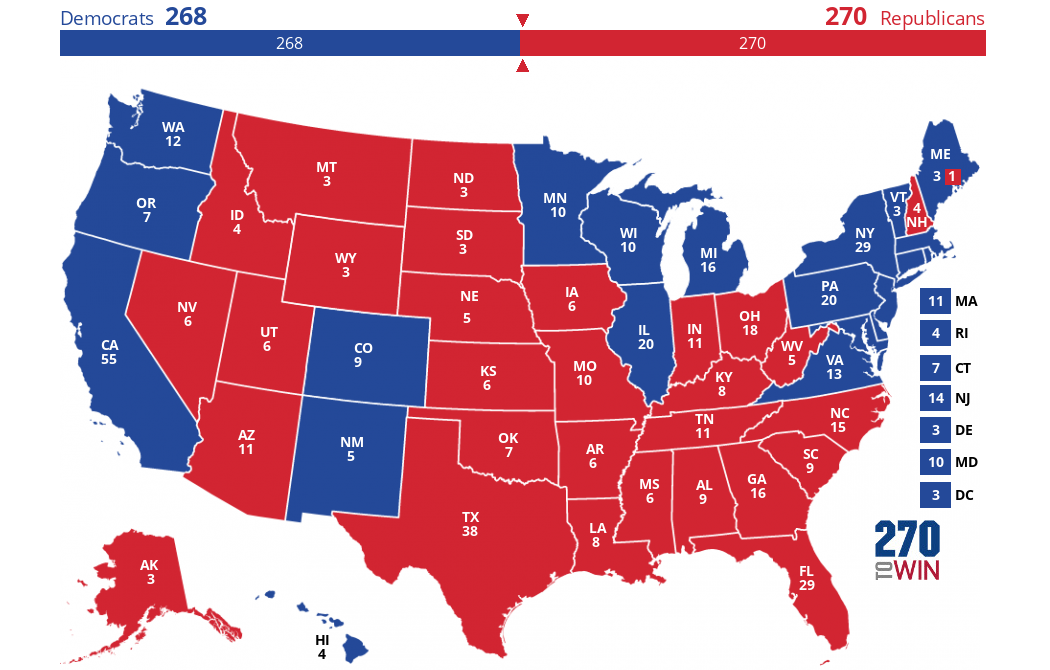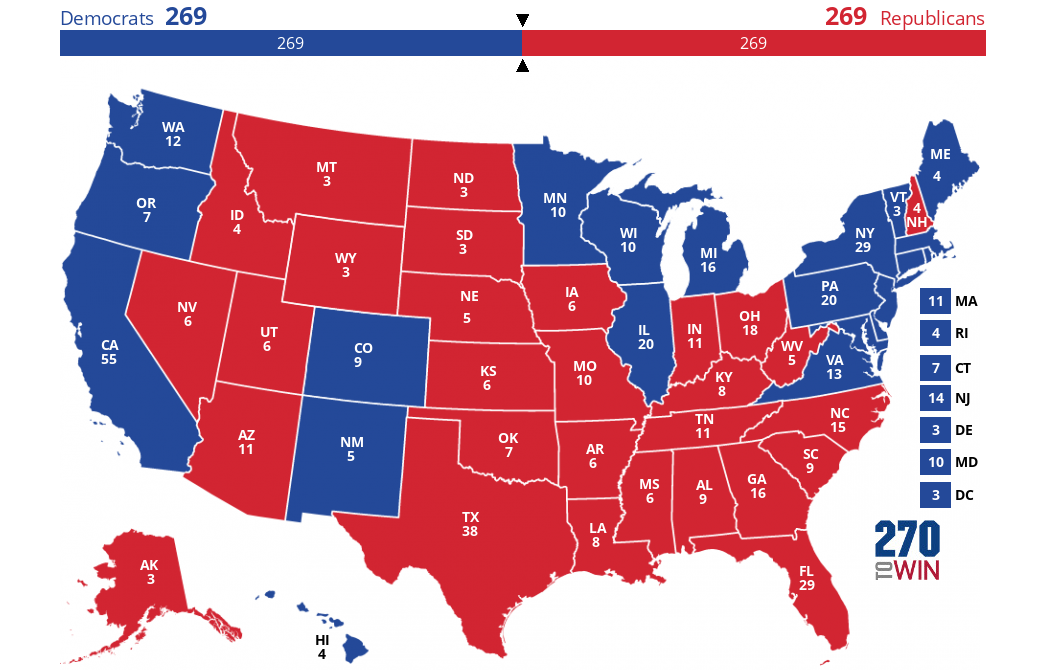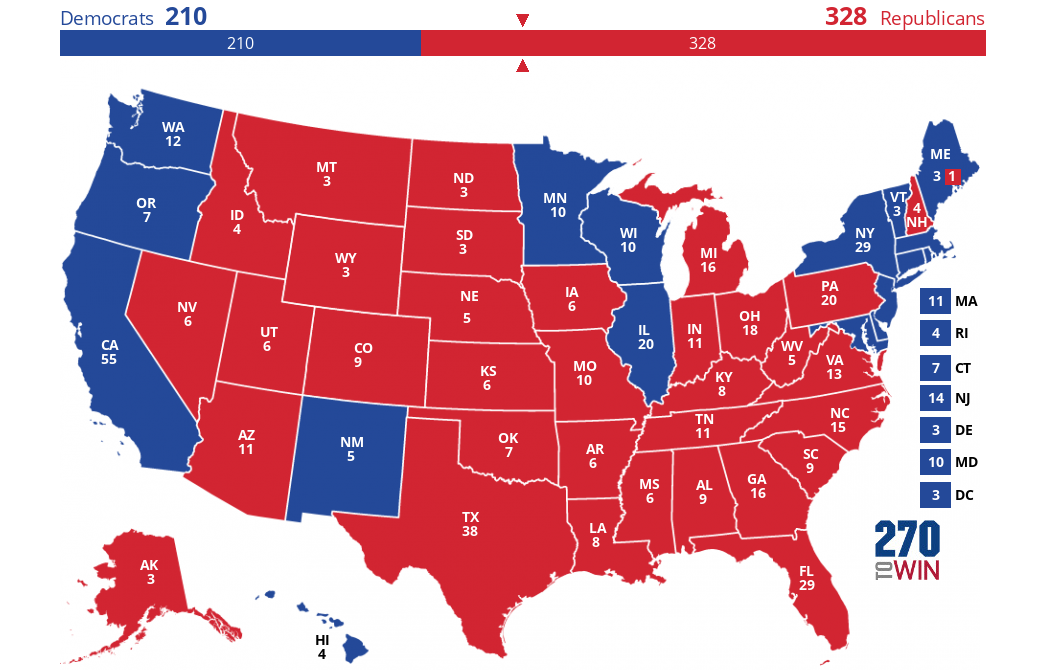By Glynn Cosker
Managing Editor, In Homeland Security
The 2016 presidential election is one for the ages – as in people of all ages are mostly disgusted by the whole thing and just want it to end. But, what if it doesn’t end on election night? What if it’s too close too call or – worse still – we end up with a 269-269 tie in the Electoral College? It’s not as outlandish as one might think.
Two of the most maligned candidates in American history will slog it out on Nov. 8 with the biggest prize in the world going to the victor. Just weeks ago, Democratic nominee Hillary Clinton had written nine-tenths of her inauguration speech, but things spiraled downhill for her after FBI Director James Comey’s “October Surprise” announcement that he was reopening the bureau’s investigation into Clinton’s private email server. Comey told Congress Sunday that he had found no new evidence to charge Clinton with any wrongdoing, but the damage may already have been done.
Clinton’s Dip in the Polls
As of Sunday night, Real Clear Politics has Clinton up by an average of 2.2 percentage points in their Trump vs. Clinton vs. Gary Johnson vs. Jill Stein poll (she enjoyed a 7.1 lead on Oct. 18 in the same poll). Similarly, FiveThirtyEight saw Clinton with an 87 percent chance of winning the election on Oct. 20, but only a 65.3 percent chance as of Sunday night. All of this does not spell disaster in any way for Clinton, particularly in light of Comey’s latest speech to Congress, because she’s in a straight race to the finish. Trump has hurdles – in the form of tossup states – and they are shown in beige on this map from 270toWin:
Effectively, Clinton already has 268 electoral votes in her pocket. Trump must run the rest of the tossup field including Maine’s second congressional district to scrape his way to the magic 270:
Here’s the rub, though: Trump is leading in the polls in all of those remaining states: Arizona, Nevada, Iowa, Florida, Georgia, Ohio, North Carolina, Maine’s second congressional district and my home state of New Hampshire – which has done a complete 180 in the polls from a strong Clinton lead to Trump sitting comfortably ahead in all polls. A month ago, this 270-vote Trump win was a Republican fantasy as every political talking head in the nation predicted Trump’s locker-room-talk Access Hollywood debacle had guaranteed a Clinton win.
[Related: Is it Time to Retire the Electoral College?]
Some other interesting facts about the above ‘near tie’ scenario: New Hampshire has correctly picked the winning presidential candidate in nine elections since 1972; Nevada has picked the winning candidate in the last nine straight elections; and Ohio has gotten it 100 percent correct since 1964 – voters there have picked the eventual president in the last 13 cycles. Trump is up by two points in all three of those states according to Real Clear Politics. These three states reflect the general feel of the nationwide electorate. President Obama took Nevada and New Hampshire by six percentage points in 2012, while he took Ohio by three points.
Those statistics should concern the Clinton camp. Of course, if Clinton wins any of the battleground states in the first map above, then all bets are off. Even New Hampshire’s four electoral votes would push Clinton past the finish line. But, what if this election turns out to be a sqeaker? That’s when the electoral college tie comes into play.
The Tied Election Scenario
Maine, including it’s second congressional district, has been solidly blue since 1992. So, let’s assume that Clinton manages to take all the electoral votes available in that state, and Trump takes all the battleground states. The result is a dead heat. There are other possible tie scenarios, but none is more likely than this:
So, what happens if there is a tie? First, if it does happen, it won’t happen for days – or even weeks – after election night. At least one, maybe two of the battleground states will be too close to call on Nov. 8, and a scenario similar to the 2000 Bush-Gore election would play out.
Should no candidate reach 270 electoral votes, then the House of Representatives decides who wins the presidency. The National Archives puts it this way:
“If no candidate receives a majority of Electoral votes, the House of Representatives elects the President from the three Presidential candidates who received the most Electoral votes. Each state delegation has one vote. The Senate would elect the Vice President from the two Vice Presidential candidates with the most Electoral votes. Each Senator would cast one vote for Vice President. If the House of Representatives fails to elect a President by Inauguration Day, the Vice-President Elect serves as acting President until the deadlock is resolved in the House.”
You’ve read that right; we may have a President Donald Trump and a Vice President Tim Kaine.
The ‘Rogue Elector’ Scenario
One might assume that a tie is effectively a presidential win for Trump. The House will be held by the Republicans who will happily (well, happily with their fingers crossed behind their backs) vote for their man. However, there is one further way for a wrench to ruin the works: The ‘rogue elector.’ Before the House ever gets their hands on the election, the mysterious Electoral College must first meet on December 19, and only half of the states require their electors to vote for the candidate who emerged victorious in their state on election night.
So, there’s a remote chance, that a ‘rogue elector’ could put one candidate over the edge in December, i.e., a Clinton supporter says “Meh! I’ll go for Trump. Blame the emails.” If that happens, well … it’s hard to imagine the consequences. It’s equally unimaginable if a ‘rogue elector’ reverses his or her vote from Trump to Clinton. Adding more intrigue to that plot is that there have been numerous such faithless electors in recent election history.
It’s clear to see how complicated and possibly horrible a tied election would be. But isn’t anything possible for this election? The same FiveThirtyEight poll that today shows Clinton with a 65.3 percent chance of winning the election, offered Trump only a two percent chance of even winning the GOP nomination at the start of the primary season.
The Silent Majority
A tie aside, there is the other big elephant in the room for the Democrats (pun intended), and that’s the so-called ‘shy Trump voter’ who is part of a silent majority. In 1980, President Jimmy Carter was a shoo-in to be re-elected and enjoyed a six-point lead in the polls in mid- to late-October of that year. The real poll though (the one which involves people casting a real vote on election day) produced a 10-point landslide for Ronald Reagan. Clearly, there were some people polled in 1980 who either changed their mind from Carter to Reagan, or were always in Reagan’s camp but shy about sharing their intentions. If, and it’s a massive ‘if,’ that same scenario plays out, it would rely on an enormous turnout for Trump on election day, with rural voters in Pennsylvania, Michigan, Colorado and Virginia causing upsets in at least two of those states by outnumbering their urban counterparts at the polls. If the silent majority shows up on Nov. 8, then this might happen:
Most pundits are predicting the opposite – a Clinton landslide in which she takes all of the battleground states or at least equals or betters President Obama’s hoard of electoral college votes in 2012. However, with this being the craziest election in American history, I’m predicting a tie; or a Trump landslide; or a Clinton landslide.
Happy voting.

 Click the map to create your own at
Click the map to create your own at 


Comments are closed.